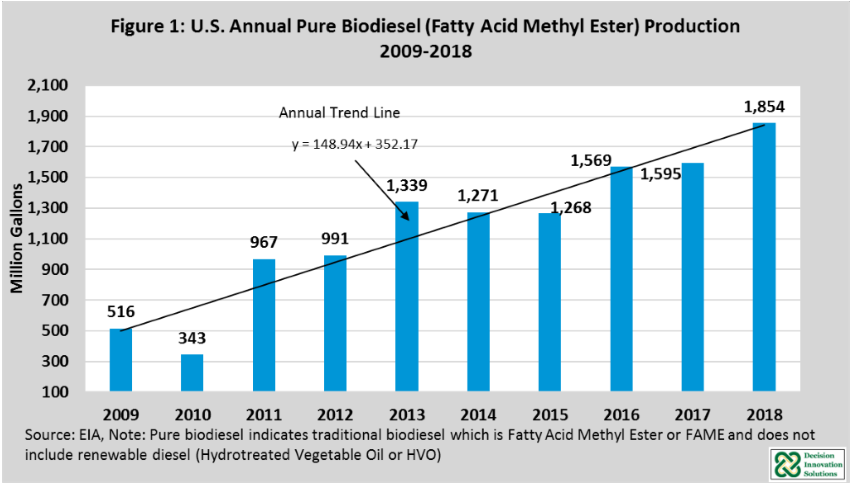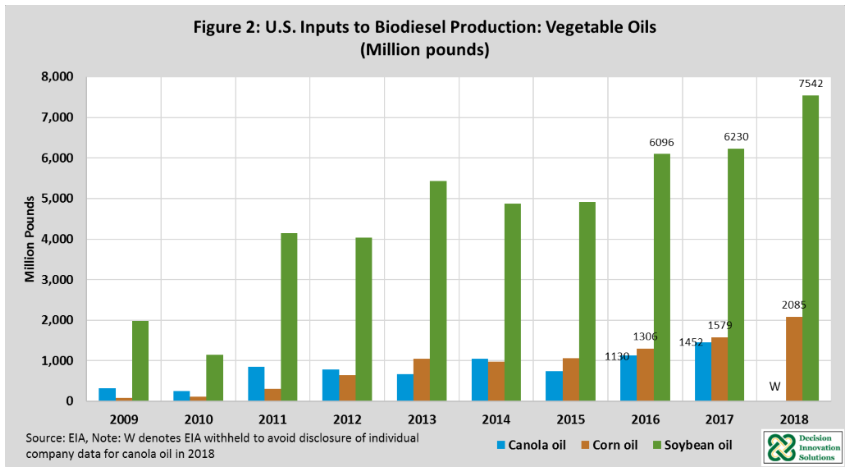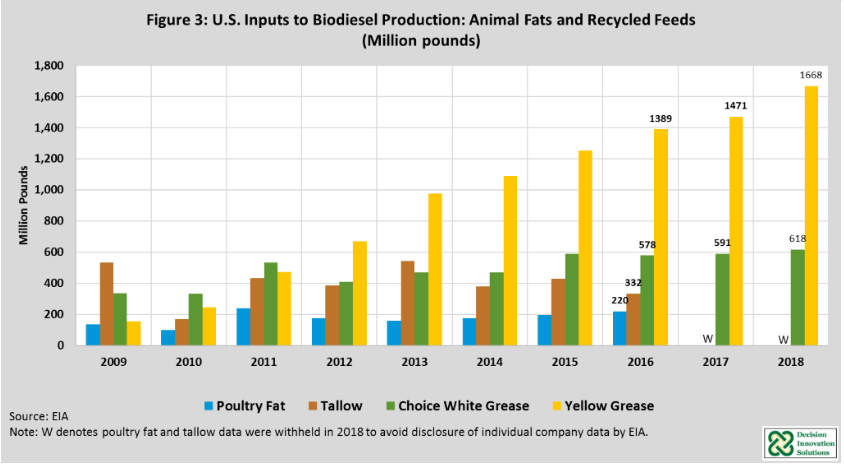In this month’s article, we look at pure biodiesel production and its feedstock usage for 2018. A previous update covering pure biodiesel production can be found in the April 2018 Report from the AgMRC Renewable Energy Report. Pure or traditional biodiesel is known as Fatty Acid Methyl Ester (FAME). Renewable diesel (also known as Hydrotreated Vegetable Oil or HVO) and FAME often are confused. These both are made from organic biomass, but are different products due to the production process and quality attributes.
Renewable diesel is produced by hydrotreating very clean biomass materials after removing impurities from the raw biomass-based feedstocks. Renewable diesel has an identical chemical composition with traditional petroleum diesel (i.e. both are hydrocarbons), and can be used in high concentration in all diesel engines. Pure biodiesel, an ester, is produced by esterifying vegetable oil and fats. The usage of pure biodiesel in high concentration can cause problems in conventional diesel engines, so in general is limited to a maximum inclusion rate of up to 20 percent (B20) in the United States.

The U.S. Energy Information Administration publishes only pure FAME-type biodiesel production in its Monthly Biodiesel Production Report. Therefore, this descriptive analysis only looks at pure FAME-type biodiesel production and its feedstocks usage for the last nine years, focusing mainly on 2018 numbers.
Figure 1 shows the U.S. production of pure biodiesel from 2009 to 2018. The U.S. production of pure biodiesel in 2018 was 1.854 billion gallons, an increase of 16 percent increase from the production in 2017. The production in 2018 is the highest recorded in U.S. history surpassing 2016 production. As shown in the annual trend line in Figure 1, U.S. pure biodiesel production has increased on average 149 million gallons each year.
Pure Biodiesel Feedstocks Usage 2009-2018
Vegetable Oils
Figure 2 shows annual usage of soybean oil, corn oil, and canola oil in pure biodiesel production from 2009 to 2018. Soybean oil remained the largest vegetable oil feedstock. The usage of soybean oil has increased by 17 percent in 2018 from 2017. However, we cannot provide quantitative comparison with other vegetable oil use as EIA withheld data for canola oil to avoid disclosure of individual company data in 2018. The usage of corn distillers’ oil (CDO) has increased to 24 percent in 2018 from 2017.

As shown in Figure 2, the U.S. biodiesel industry used 7,542 million pounds of soybean oil in 2018, compared to 6,230 million pounds in 2017. The monthly data published by the National Agricultural Statistics Service, USDA (USDA-NASS) indicates U.S. soybean oil total domestic disappearance in 2018 was 20,921 million pounds. This shows the biodiesel industry utilized approximately 36 percent of the total soybean oil demand in the United States in 2018.
Total usage of CDO in pure biodiesel production in 2018 was 2,085 million pounds compared to 1,579 million pounds in 2017. Total U.S. production of CDO was 1.896 million tons in 2018 based on the Grain Crushings and Co-Products Production report published by the National Agricultural Statistics Service, USDA (USDA-NASS). This indicates approximately 55 percent of total CDO production was utilized by the U.S. pure biodiesel industry in 2018.
Animal Fats and Recycled Feeds
Figure 3 shows annual usage of yellow grease, choice white grease, tallow, and poultry fat in pure biodiesel production from 2009 to 2018. Yellow grease remained the largest animal fats and recycled feed inputs in the U.S. biodiesel production.

The U.S. biodiesel industry used 1,668 million pounds of yellow grease in 2018, compared to 1,471 million pounds in 2017, an increase of 13 percent. Total choice white grease usage was 618 million pounds in 2018, compared to 591 million pounds in 2018, an increase of 5 percent. Poultry fat and tallow usage data were withheld by EIA in 2018 to avoid disclosure of individual company data.

